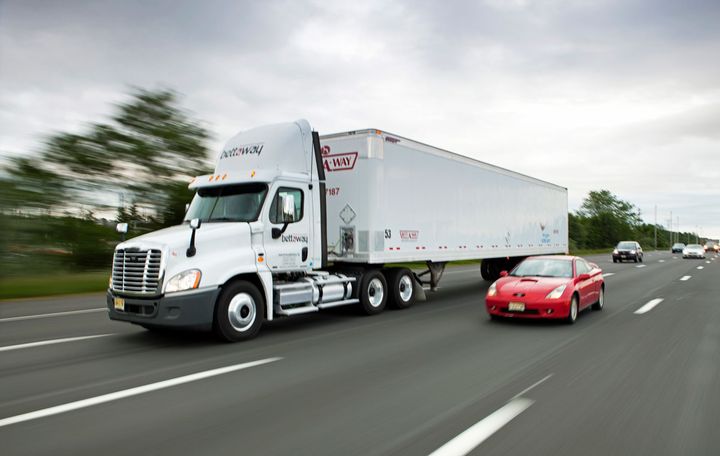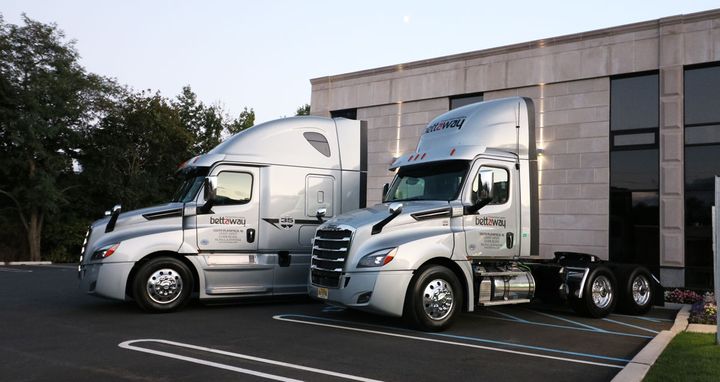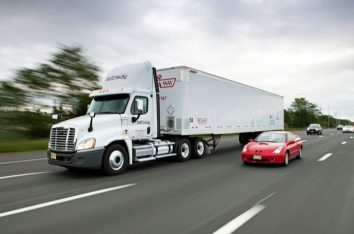Deborah Lockridge, Trucking Info, May 20, 2021, Full article
John Vaccaro was having lunch with a customer when the mobile phone in his pocket started blowing up. It wouldn’t stop. He had a message from his office, “You need to call right now.”
“At that moment, I knew it was something bad,” he recalls. Yet at that moment in 2017, he really did not know just how bad it was going to get for him, his business, and his family.
Vacarro is president of Bettaway Beverage Distributors, a 38-year-old, New Jersey-based, family-owned trucking company.
Operating primarily in the congested area around New York City, where many roads were never designed for modern trucks, Vaccaro acknowledges that despite the company’s emphasis on safety, it wasn’t uncommon to have merge accidents, blind-spot accidents, fender-benders and bumper thumpers. “Nothing I would have called significant,” he says. Nevertheless, settlements had been creeping higher and higher and insurance costs were rising.

This crash was different.
One of his drivers had been involved in a crash with severe injuries among the occupants of the other vehicle – severe enough to require medevac by helicopter.
“I go home that night, and I am totally devastated,” he recalls. “I’m just overwhelmed by what occurred, even though I don’t know too much. I just knew that there was injured people. And there’s no good feeling of being the owner of a trucking company when there’s injuries involved,” no matter who’s at fault.
“I remember lying down that night on the floor in the basement of my home, [thinking], ‘What could I have done to prevent this?’”
The equipment was new, it wasn’t overloaded, and the driver still had plenty of hours of service left. (Bettaway was an early adopter of electronic logs, back in 1997.)
“I realized that what we need to do is every single thing we could possibly do to prevent” such crashes from happening in the future, Vaccaro says, from technology such as collision avoidance and in-cab cameras to stronger driver training and safety programs. “And that was the path that we set out on.”
A Three-Year Nightmare
After what Vaccaro describes as an “uncomfortable period of silence,” the attorney hired by Bettaway’s insurance company came to meet with him and other company representatives.
“It was near having the grim reaper come and visit you,” Vaccaro recalls.
The plaintiffs’ attorney, the lawyer said, was determined to go after everything he could possibly get.
“The attorney started talking about a $20, $30, $40 million dollar verdict greater than what our insurance covers. I started thinking to myself, ‘What does that mean? We don’t have that type of money.’”
At the time, Bettaway had $5 million in coverage, seven times the legal minimum, and had never had an incident that even came close to piercing the umbrella, Vaccaro says.
“After that, it was nothing but a nightmare for three years.”
The plaintiffs’ attorneys went after Bettaway’s affiliated companies, which included a third-party logistics business, a pallet business, and an operation in California. Bettaway had to hire its own attorneys to defend those, in addition to the one from the insurance company. They were eventually successful in removing those other entities from the litigation. But offers of out-of-court settlements were rejected.
As the jury was being selected, Vaccaro told his attorney he wanted one last shot at mediation.
“I was told I was wasting my time,” he recalls. “My feeling was if I stood in front of a judge and said, ‘I want to settle, I want to get this worked out,’ what judge would refuse that?”
And it worked. After an eight-hour, court-ordered mediation, a settlement was reached, narrowly avoiding what the attorney estimated could have been a $40 million to $70 million “nuclear verdict.”
A Wake-up Call
The crash was a wake-up call for Vaccaro and his company. Since then, he has put into place an aggressive driver training and risk avoidance program, including the use of in-cab cameras and collision avoidance systems.

“We doubled down, we tripled down, on technology and equipment.”
Even before the crash, Bettaway started ordering trucks with collision avoidance with active braking as soon as Freightliner made them available. But by the time of the crash in 2017, only about 15% of the fleet had the technology.
“To me, that was number one, to accelerate purchases and trade-outs of our equipment to try to get almost all of our trucks with collision avoidance,” Vaccaro says. Today, more than 90% of the fleet is equipped with the technology. All new tractors (2015 and newer models) are spec’ed with advanced driver assistance systems, including Detroit Assurance collision warning, adaptive cruise control and active brake assist, as well as the Bendix side-object detection system. The spec also includes automated transmissions so drivers can focus on driving rather than shifting.
The other big technology change he made was adopting in-cab cameras.
“There was a lot of speculation over what happened with this accident,” he recalls. “We wished there was a camera there.”
Although he had considered in-cab cameras before, the technology was undergoing major changes in this time
frame. Vaccaro liked the fact that the cameras could provide video both shortly before and after a crash or a triggering incident such as hard braking. And unlike the collision-avoidance technology, he would be able to deploy it on every truck within a few weeks. He chose the DriveCam system by Lytx and rolled it out in January of 2018.
“DriveCam’s made a tremendous difference,” Vaccaro says. While some drivers and motor carriers may worry that cameras could be used against them, he says, in nearly every incident they have exonerated Bettaway and its drivers.
“We have a file of some of our favorite DriveCam clips saved. One after another, it’s people cutting off trucks, and we’ve got the video to prove it.”
He uses those videos to address concerns from drivers, especially since the system uses both forward- and driver-facing cameras.
“Whenever we have driver safety meetings, we always promote the videos of all the times it’s saved us in the previous few months.”
There are times when the DriveCam system has alerted the company to problematic driver behaviors such as holding a phone or distracted driving. However, they are few, Vaccaro says, and offer the company an opportunity to deal with them through coaching or other measures.
Changing the Narrative
Vaccaro shares a particularly egregious incident where these aggressive safety measures paid off.
Last December, a Bettaway driver was traveling along a divided highway, on a clear day, at 68 mph on cruise control. Just ahead, a passenger car had just exited the highway. Suddenly, apparently realizing it was the wrong exit, the driver cut across the area between the exit and the highway and pulled directly in front of the Bettaway truck.


Although the quick actions of the truck driver and the collision avoidance system brought the truck down to just 32 mph, he couldn’t avoid hitting the car.
All this was clearly visible in the two-way video from the in-cab camera.
The driver of the passenger vehicle was taken to the hospital, where she told police a very different story, as Vaccaro discovered a few days later when he got “a very aggressive attorney letter.” That letter said the passenger car driver was slowing her vehicle to accommodate the recommended speed of the exit ramp when she was suddenly “hit from behind at an extremely high rate of speed by your [driver].”
What that attorney didn’t know was that Bettaway had already shared the video with the police. When the police report came out, it cited the driver of the passenger vehicle for several violations and concluded she was the sole cause of the accident.
The litigation was quickly withdrawn.
“Had we not had that video, what would the narrative had been?” Vaccaro wonders.
A Culture of Safety
Vaccaro says Bettaway has always prioritized safety, pointing to its early adoption of electronic logs and collision-avoidance technology.
“The accident was not an event that took us from bad to great,” he says. “It took us from good to excellent, or better than excellent.”
Each year, Bettaway puts together a comprehensive report about its safety programs and performance.
In addition to doubling down on technology, Bettaway doubled down on its driver training and safety incentives. For instance, it’s now paying out cash safety bonuses monthly.
“We don’t look for things like a broken light or mudflap to disqualify a driver,” Vaccaro says. “We don’t want to catch them being bad. We want to make opportunities where we can catch them being good.”
What does Vaccaro want other fleets to take away from his experience?
In addition to making sure you have a large umbrella policy, he says, “Don’t be scared of technology. Embrace it. Embrace the DriveCams. Embrace the collision avoidance. Embrace all of those things, because if not, you’re not going to be in business. Either the insurance is going to take you down or an accident’s going to take you down.”
Read More


